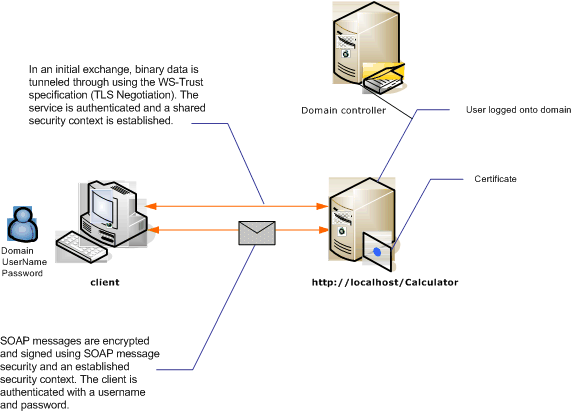Nachrichtensicherheit über einen Benutzernamenclient
Die folgende Abbildung zeigt einen WCF-Dienst (Windows Communication Foundation) und einen Client, die mit der Sicherheit auf Nachrichtenebene gesichert sind. Der Dienst wird über ein X.509-Zertifikat authentifiziert. Der Client wird über den Benutzernamen und das Kennwort authentifiziert.
Eine Beispielanwendung finden Sie unter Nachrichtensicherheit – Benutzername.

| Merkmal | Beschreibung |
|---|---|
| Sicherheitsmodus | `Message` |
| Interoperabilität | Nur Windows Communication Foundation (WCF) |
| Authentifizierung (Server) | Für die erste Aushandlung ist eine Serverauthentifizierung erforderlich |
| Authentifizierung (Client) | Benutzername/Kennwort |
| Integrität | Ja, mit freigegebenem Sicherheitskontext |
| Vertraulichkeit | Ja, mit freigegebenem Sicherheitskontext |
| Transport | HTTP |
| Bindung | WSHttpBinding |
Dienst
Der folgende Code und die folgende Konfiguration werden unabhängig voneinander ausgeführt. Führen Sie eines der folgenden Verfahren aus:
Erstellen Sie einen separaten Dienst, indem Sie den Code ohne Konfiguration verwenden.
Erstellen Sie mit der angegebenen Konfiguration einen Dienst, aber definieren Sie keine Endpunkte.
Code
Im folgenden Code wird gezeigt, wie ein Dienstendpunkt, der Nachrichtensicherheit verwendet, erstellt wird.
// Create the binding.
WSHttpBinding binding = new WSHttpBinding();
binding.Security.Mode = SecurityMode.Message;
binding.Security.Message.ClientCredentialType =
MessageCredentialType.UserName;
// Create the URI for the endpoint.
Uri httpUri = new Uri("http://localhost/Calculator");
// Create the service host.
ServiceHost myServiceHost =
new ServiceHost(typeof(Calculator), httpUri);
myServiceHost.AddServiceEndpoint(typeof(ICalculator), binding, "");
// Specify a certificate to authenticate the service.
myServiceHost.Credentials.ServiceCertificate.
SetCertificate(StoreLocation.LocalMachine,
StoreName.My,
X509FindType.FindBySubjectName,
"Contoso.com");
myServiceHost.Open();
Console.WriteLine("Listening...");
Console.ReadLine();
// Close the service.
myServiceHost.Close();
' Create the binding.
Dim binding As New WSHttpBinding()
binding.Security.Mode = SecurityMode.Message
binding.Security.Message.ClientCredentialType = MessageCredentialType.UserName
' Create the URI for the endpoint.
Dim httpUri As New Uri("http://localhost/Calculator")
' Create the service host.
Dim myServiceHost As New ServiceHost(GetType(ServiceModel.Calculator), httpUri)
myServiceHost.AddServiceEndpoint(GetType(ICalculator), binding, "")
' Specify a certificate to authenticate the service.
myServiceHost.Credentials.ServiceCertificate.SetCertificate(StoreLocation.LocalMachine, _
StoreName.My, X509FindType.FindBySubjectName, "Contoso.com")
myServiceHost.Open()
Console.WriteLine("Listening...")
Console.ReadLine()
' Close the service.
myServiceHost.Close()
Konfiguration
Die folgende Konfiguration kann statt des Codes verwendet werden:
<?xml version="1.0" encoding="utf-8"?>
<configuration>
<system.serviceModel>
<behaviors>
<serviceBehaviors>
<behavior name="ServiceCredentialsBehavior">
<serviceCredentials>
<serviceCertificate findValue="Contoso.com"
storeLocation="LocalMachine"
storeName="My"
x509FindType="FindBySubjectName" />
</serviceCredentials>
</behavior>
</serviceBehaviors>
</behaviors>
<services>
<service behaviorConfiguration="ServiceCredentialsBehavior"
name="ServiceModel.Calculator">
<endpoint address="http://localhost/Calculator"
binding="wsHttpBinding"
bindingConfiguration="MessageAndUserName"
name="SecuredByTransportEndpoint"
contract="ServiceModel.ICalculator" />
</service>
</services>
<bindings>
<wsHttpBinding>
<binding name="MessageAndUserName">
<security mode="Message">
<message clientCredentialType="UserName" />
</security>
</binding>
</wsHttpBinding>
</bindings>
<client />
</system.serviceModel>
</configuration>
Client
Code
Der folgende Code erstellt den Client. Die Bindung bezieht sich auf den Nachrichtensicherheitsmodus, und der Clientanmeldeinformationstyp wird auf UserName festgelegt. Der Benutzername und das Kennwort können nur mit Code (nicht konfigurierbar) angegeben werden. Der Code zum Zurückgeben des Benutzernamens und des Kennworts ist hier nicht gezeigt, da dies auf Anwendungsebene erfolgen muss. Verwenden Sie z. B. ein Windows Forms-Dialogfeld, um vom Benutzer Daten abzufragen.
// Create the binding.
WSHttpBinding myBinding = new WSHttpBinding();
myBinding.Security.Mode = SecurityMode.Message;
myBinding.Security.Message.ClientCredentialType =
MessageCredentialType.UserName;
// Create the endpoint address.
EndpointAddress ea = new
EndpointAddress("http://machineName/Calculator");
// Create the client.
CalculatorClient cc =
new CalculatorClient(myBinding, ea);
// Set the user name and password. The code to
// return the user name and password is not shown here. Use
// an interface to query the user for the information.
cc.ClientCredentials.UserName.UserName = ReturnUsername();
cc.ClientCredentials.UserName.Password = ReturnPassword();
// Begin using the client.
try
{
cc.Open();
Console.WriteLine(cc.Add(200, 1111));
Console.ReadLine();
// Close the client.
cc.Close();
}
' Create the binding.
Dim myBinding As New WSHttpBinding()
myBinding.Security.Mode = SecurityMode.Message
myBinding.Security.Message.ClientCredentialType = _
MessageCredentialType.UserName
' Create the endpoint address.
Dim ea As New EndpointAddress("http://machineName/Calculator")
' Create the client.
Dim cc As New CalculatorClient(myBinding, ea)
' Set the user name and password. The code to
' return the user name and password is not shown here. Use
' an interface to query the user for the information.
cc.ClientCredentials.UserName.UserName = ReturnUsername()
cc.ClientCredentials.UserName.Password = ReturnPassword()
' Begin using the client.
Try
cc.Open()
Console.WriteLine(cc.Add(100, 11))
Console.ReadLine()
' Close the client.
cc.Close()
Catch tex As TimeoutException
Console.WriteLine(tex.Message)
cc.Abort()
Catch cex As CommunicationException
Console.WriteLine(cex.Message)
cc.Abort()
Finally
Console.WriteLine("Closed the client")
Console.ReadLine()
End Try
Konfiguration
Der folgende Code dient zum Konfigurieren des Clients. Die Bindung bezieht sich auf den Nachrichtensicherheitsmodus, und der Clientanmeldeinformationstyp wird auf UserName festgelegt. Der Benutzername und das Kennwort können nur mit Code (nicht konfigurierbar) angegeben werden.
<?xml version="1.0" encoding="utf-8"?>
<configuration>
<system.serviceModel>
<bindings>
<wsHttpBinding>
<binding name="WSHttpBinding_ICalculator" >
<security mode="Message">
<message clientCredentialType="UserName" />
</security>
</binding>
</wsHttpBinding>
</bindings>
<client>
<endpoint address="http://machineName/Calculator"
binding="wsHttpBinding"
bindingConfiguration="WSHttpBinding_ICalculator"
contract="ICalculator"
name="WSHttpBinding_ICalculator">
<identity>
<dns value ="Contoso.com" />
</identity>
</endpoint>
</client>
</system.serviceModel>
</configuration>